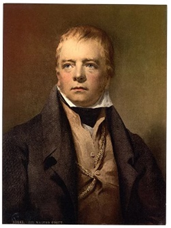Sir Walter Scott
1771-1832
Scottish historical novelist, playwright, poet and historian. Many of his works remain classics of both English-language and Scottish literature. Famous titles include Ivanhoe, Rob Roy, Old Mortality, The Lady of the Lake, Waverley, The Heart of Midlothian and The Bride of Lammermoor. Although primarily remembered for his extensive literary works and his political engagement, Scott was an advocate, judge and legal administrator by profession, and throughout his career combined his writing and editing work with his daily occupation as Clerk of Session and Sheriff-Depute of Selkirkshire. A prominent member of the Tory establishment in Edinburgh, Scott was an active member of the Highland Society and served a long term as President of the Royal Society of Edinburgh (1820–32). Although Scott had attained worldwide celebrity through his poetry, he soon tried his hand at documenting his researches into the oral tradition of the Scottish Borders in prose fiction—stories and novels—at the time still considered aesthetically inferior to poetry (above all to such classical genres as the epic or poetic tragedy) as a mimetic vehicle for portraying historical events. In an innovative and astute action, he wrote and published his first novel, Waverley, anonymously in 1814. There followed a succession of novels over the next five years, each with a Scottish historical setting. Mindful of his reputation as a poet, Scott maintained the anonymity he had begun with Waverley, publishing the novels under the name "Author of Waverley" or as "Tales of..." with no author. After George's accession to the throne, the city council of Edinburgh invited Scott, at the King's behest, to stage-manage the 1822 visit of King George IV to Scotland. With only three weeks for planning and execution, Scott created a spectacular and comprehensive pageant, designed not only to impress the King, but also in some way to heal the rifts that had destabilised Scots society. He used the event to contribute to the drawing of a line under an old world that pitched his homeland into regular bouts of bloody strife. He, along with his "production team", mounted what in modern days could be termed a PR event, in which the King was dressed in tartan, and was greeted by his people, many of whom were also dressed in similar tartan ceremonial dress. This form of dress, proscribed after the 1745 rebellion against the English, became one of the seminal, potent and ubiquitous symbols of Scottish identity. n 1825 a UK-wide banking crisis resulted in the collapse of the Ballantyne printing business, of which Scott was the only partner with a financial interest; the company's debts of £130,000 (equivalent to £9,800,000 in 2016) caused his very public ruin. Rather than declare himself bankrupt, or to accept any kind of financial support from his many supporters and admirers (including the king himself), he placed his house and income in a trust belonging to his creditors and determined to write his way out of debt. He kept up his prodigious output of fiction, as well as producing a biography of Napoleon Bonaparte, until 1831. By then his health was failing, but he nevertheless undertook a grand tour of Europe, and was welcomed and celebrated wherever he went. He returned to Scotland and, in September 1832, during the epidemic in Scotland that year, died of typhus at Abbotsford, the home he had designed and had built, near Melrose in the Scottish Borders.
